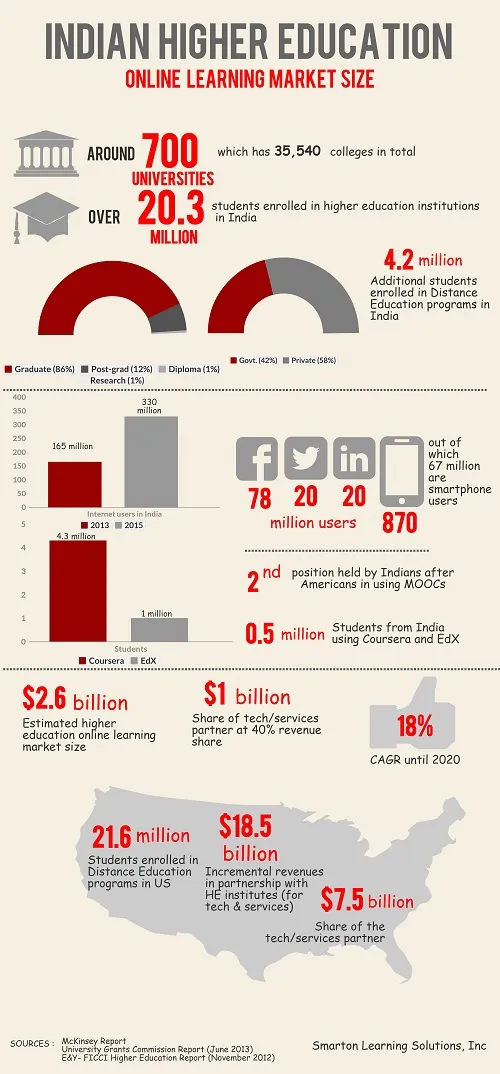How startups can crack a $40 billion market with job-oriented MOOCs
Stanford University Professor Sebastian Thrun kicked off a revolution three years ago when he decided to video record his lecturers on artificial intelligence and make it freely available online. About 160,000 students from all corners of the planet signed up for the free lessons, which cost $52,000 a year offline at Stanford. That was the beginning of project Udacity, which spurred almost all top universities in the world from Harvard to MIT to board the MOOCs bandwagon. A few others like ALISON (Advance Learning Interactive Systems Online), an e-learning provider in Ireland started by serial entrepreneur Mike Feerick, had entered the MOOC field in 2007. MIT Open Courseware was a precursor of all these, but it only made resources available, and was not intended to be an online course. It took Professor Thrun to establish MOOC – massive open online course – as a compelling answer to the changing needs of education in the modern day. That was just the first big wave though.

Soon, data bowled a googly at the professor. Udacity had 1.6 million students registered with it but just about 10% of them actually finished the course they enrolled for. And of those, about 5% qualified for a passing grade. This data shook him up enough to provoke a pivot in the strategy: to dump the freemium model. Instead charge money for classes and abandon academic disciplines in favour of more vocational-focused learning.
This wave too is churned by technology, the omnipresent, omnipotent force of modern day shaping, honing and disrupting every aspect of our daily lives.
What is the problem the MOOC will solve?
With MOOCs, access to university-level education is no longer dependent on merit or means but simply on the enthusiasm and commitment of the student. This student-driven wave has forced educators and startups in this space to think: “What is the problem I'm going to solve?” Sumit Sahni, Head – Solution Design & Delivery (South Asia & Middle East), Harvard Business Publishing, says it is important to deliver “parameterized solutions based on the pain-points of the industry.”

For example, SmartOn Learning, a global education company, launched a MOOC in ecommerce on 17 February 2014. Close to 1000 students from over 20 countries have enrolled for it. Students will be taught ecommerce concepts, trends, business processes and how to set up an online store. Web tutorials, discussion forums, expert advice and interaction with participants from across the world are part of it. “The value of traditional degrees is declining as the focus is shifting more towards the skills and competencies of the candidates rather than their credentials. In a country like India, higher education faces several infrastructure and quality challenges. These are affecting the employabilty and career prospects of millions of students,” says Rakshit Kejriwal, Co-Founder of SmartOn, on the need for such a course.It is this gap between higher education and employability that prompted Rakshit, a certified Chartered Accountant with an MBA from Columbia Business School, New York, to startup with his friend, Chaitanya Chitta. Chaitanya had earlier worked in the higher education space during his six-year stint as one of the directors of KPMG.
SmartOn started offering its courses in October 2013, and already has a few high-profile partners. Columbia University is their academic partner, KPMG and Shopify are industry partners, Canvas is the technology partner, and Laureate Education is a client. The company is headquartered in New York with Bangalore as its India operations centre.
Last week, Google launched a MOOC called 'Making Sense of Data'. Self-paced and self-driven, the course will run from 18 March to 4 April, 2014 and will be taught by Google content experts Amit Deutsch and Joe Hollerstein via a series of video lectures, interactive projects, and the support of community Teaching Assistants. Users will have the option of claiming a ‘Certificate of Completion’ if they finish the modules and the assignment.
How MOOC evolved from OER
The first MOOCs emerged from the open educational resources (OER) movement. Open educational resources include full courses, course materials, modules, textbooks, streaming videos, tests, software, and any other tools, materials, or techniques used to support access to knowledge.This OER movement was sparked off globally by the MIT OpenCourseWare project announced in 2001.
A lot of established players are already in the OER space, but it is constantly evolving. For example, Progia LLC, a New Jersey-based company, ventured into it two years ago with a "learning management platform” that schools and training centers can use to integrate OER in their curriculum effortlessly. According to its founder and CEO Dr. Mahendra Pratap, there is sufficient room for innovation and market segmentation in education as OER, always connected mobile devices and social media are transforming the milieu. A scientist and an entrepreneur, Mahendra has a PhD in Nuclear Physics and has authored over two dozen scientific papers.
“One learning, I would like to share, is that after being very clear about your vision or an innovative idea, one needs to firmly ground it in a specific customer need or pain point. Solving a specific need for one customer, you begin to see the next steps towards your goal more clearly,” he says.
While most MOOC platforms focus on content creators, there are also products like Uzity by Foradian focussing on school and college teachers, who are the enablers on the ground. Foradian was the winner of YourStory's annual education startup contest, Edustars 2012.
Troubles, opportunities
India Ratings and Research Pvt. Ltd estimates the Indian education market to be worth Rs.5.9 trillion in 2014-15. A young demographic is driving the demand, with nearly half the population below the age of 25, but infrastructure and regulatory bottlenecks are muddying the waters. Such a scenario coupled with growing Internet usage means the sector with the biggest potential is e-learning. India’s online education market size is thus predicted to grow to $40 billion by 2017 from the present $20 billion.
The size of the market makes it a fertile ground for MOOCs. A University of London study, which tracked four new Mooc courses launched with the US-based provider Coursera in autumn 2013, found that India accounted for the second biggest proportion of students, with 6% of participants.
Another factoid the study threw up was that 70% of the enrolled students already held a degree, while 35% were already enrolled with another education provider. Recently published demographic data released by UK-based Mooc provider FutureLearn, said that more than 80% of the students who enrolled for Moocs had already secured a higher education qualitification.
Yes, the market is huge, but the teething troubles are far from over. Most of the Mooc students still treat the course as a resource or a text rather than as a course. Studies show that the freedom to join or back out whenever they want hasn't fared too well so far. A study done by University of Pennsylvania showed that an average of only four per cent of registered users finished their MOOCs, and half of those enrolled did not view even a single lecture. EdX, a MOOC collaboration between Harvard and the Massachusetts Institute of Technology, has shown results that are a little more encouraging, but not much. We also know that the partnership between San Jose State and Udacity failed.
With established players struggling to find a good footing, it remains to be seen if education startups, who are quick to innovate, pivot and think out of the box, will manage to crack it.
For example, Australian National University (ANU) will launch an EdX MOOC called Engaging India in two months' time, which will be available in both English and Hindi. What is new about the course is that it will be bilingual. Watch out for more innovations in this space. Any ideas? Please share them with us in the comments below.







